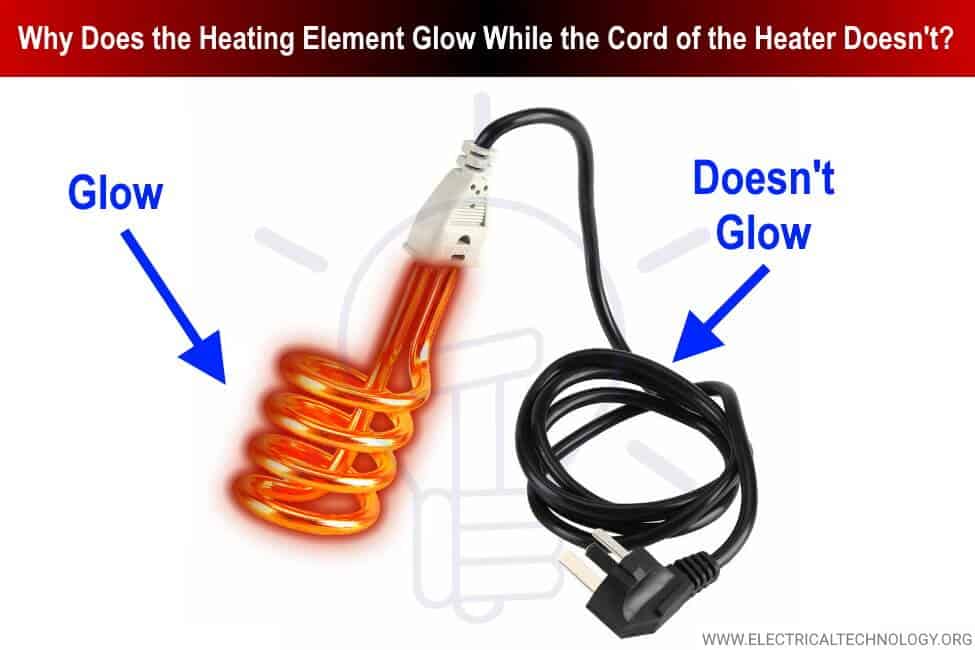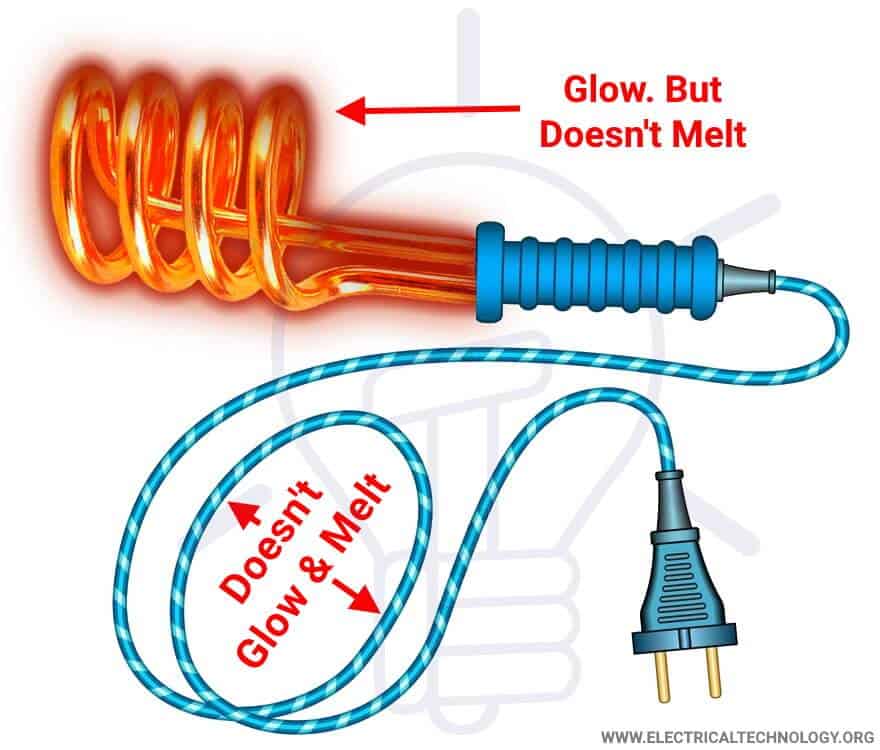Why Does the Heating Element Glow but Not the Cord of Heater?
Why Does the Heating Element Glow While the Cord of the Heater Doesn’t?
It is a matter of common experience when the element of the heater connects to the electric supply, It becomes hot and starts to glow after some time. This effect is known as the heating effect of electric current or the Joule effect. In this case, two additional points are noticeable viz,
- Heater element glows but not the cord of the heater
- Heating elements glows but not melts
Why Does the Heating Element Glow but not the Cable Connected to it?
Generally, the heating elements of stoves, water heaters and other electric heaters are made-up of alloys or elements having a very high resistance, resistivity (specific resistance “ρ”) and positive temperature coefficient “α” such as Tungsten, Nichrome etc.
On the other hand, the power cords, cables and flex wires are made of elements or alloys having very high conductivity such as Copper, Silver, Aluminum (which has very low resistance etc. To understand the basic concepts, let’s see what is resistance and conductance of a material.
- Resistance “represented by the symbol of Ohm “Ω” is the property of a material which opposes the flow of electrons (electricity) through it. In other words, the ability of a circuit or material to oppose electric current is known as resistance.
- Conductance “represented by the symbol of Mho “℧” or Siemens (S) is the ability of a circuit or material to permit electric current flow in it. In other words, the reciprocal of respace is known as conductivity.
Now when the supply voltage is applied across the heating element through the wire, the cord of the heater allows the current flow easily in it. In other words, the cord of the heater is made of conductors (having negligible resistance) where electric current easily flows from the source to the heating element. That’s why the cord of the heater doesn’t glow or melt.
When the current starts to flow in the heating element, it opposes the flow of charge or current through it as the heating material has very high resistance.
While the electrons still struggle to move forward due to the mains supply. In this scenario, the electrons collide with each other as well as other electrons in the molecule and atoms of that material having high resistance. As a result of collision of electrons, the heating element heats-up and starts to glow. This power dissipation (same like in resistors) leads to the process of conversion of electrical energy into heat energy.
In very simple words, the heating element converts the applied electrical energy into heat energy. This whole process is known as the heating effect of electric current which has multiple and useful applications in households as well industrial purposes.
Why Does the Heating Element Glow but doesn’t melt?
As discussed earlier, the heating element has very high resistance, resistivity (specific resistance “ρ“) and positive temperature coefficient “α“, that’s the reason why the heating element only glows but doesn’t melt.
Good to know:
- Resistivity or Specific Resistance “ρ”: It is the resistance between opposite faces of a meter (or centimeter) cube (or unit cube of that material).
Resistivity or Specific Resistance of Copper and Tungsten is 1.7 x 10-6 and 5.6 x 10-6 respectively.
- Temperature Coefficient “α”: The increase in resistance per ohm original reissuance per °C rise in a temperature is called temperature coefficient OR Temperature coefficient of resistance is the amount by which resistance changes when temperature changes by one degree centigrade “°C”.
Positive Temperature Coefficient means resistance increases when temperature increases in case of pure metals and alloys.
Negative Temperature Coefficient means resistance decreases when temperature increases in case of non-metals such as carbon, insulator (paper, mica etc.) and thermistors ( oxides of Nickel, Copper and manganese).
Related Useful Posts:
- Ferrite Bead: Tiny Cylinder in Power Cords & Cable. Why?
- What Happens if We Connect a Polar Capacitor the Wrong Way?
- What Happens if a Battery is Connected to the AC Supply?
- What Happens to the Battery with Reverse Polarity Wiring Connection
- Difference Between Grounding, Earthing and Bonding
- Why are Stones laid in an Electrical Substation?
- Why Electric Power Transmission is Multiple of 11 i.e 11kV, 22kV, 66kV etc?
- Why is Zero Ohm Resistor Used? 0-Ω Resistor Applications
- Difference Between GFCI and AFCI
- Difference Between Overcurrent, Overload and Overvoltage
- Can We Use AC Circuit Breaker for DC Circuit & Vice Versa?
- Which One Kills – Current or Voltage and Why? Amps vs. Volts
- Why Circuit Breaker Capacity Was Rated in MVA and Now in kA and kV?
- Which Bulb Glows Brighter When Connected in Series and Parallel & Why?








